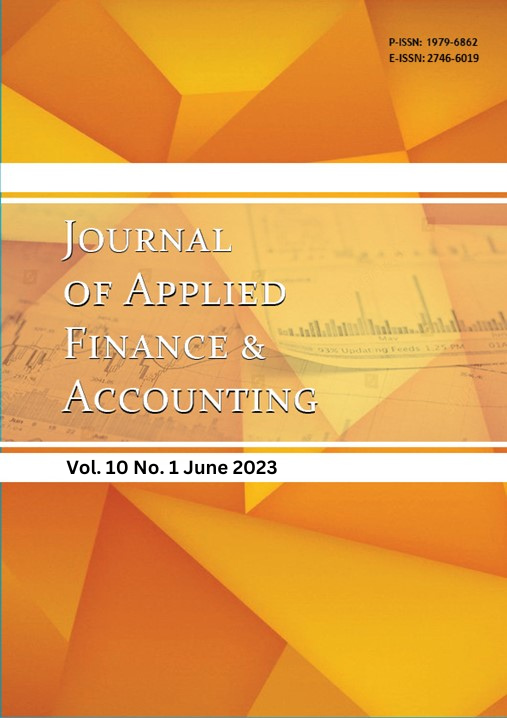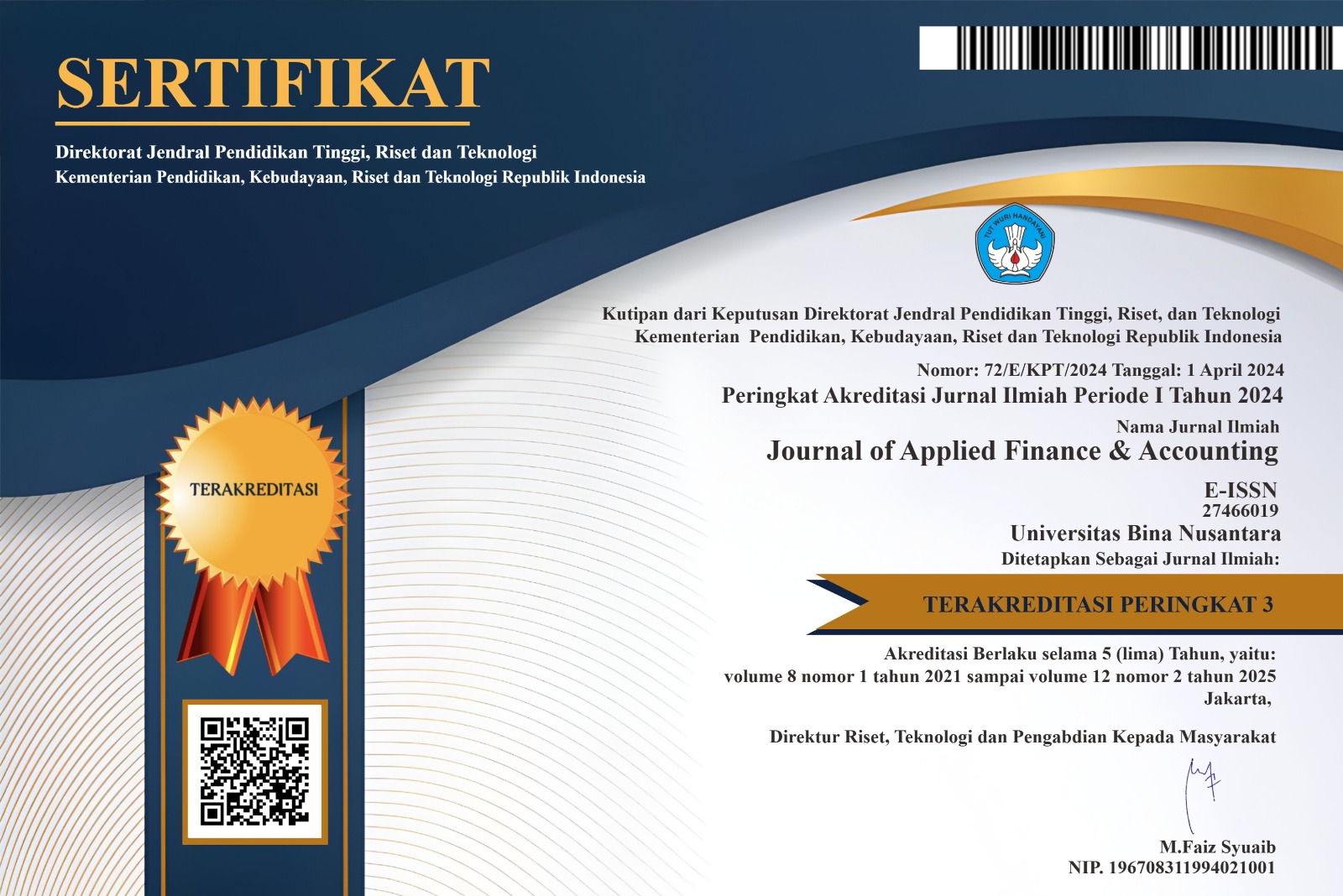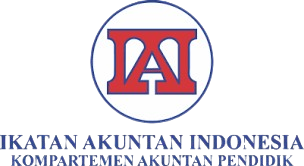ANALYZING THE EFFECT OF FACTORS ON TAXPAYERS SATISFACTION USING E-FILING TAX REPORTING SYSTEM
DOI:
https://doi.org/10.21512/jafa.v10i1.8323Keywords:
system quality, information quality, service quality, user satisfaction of the E-Filing System, DeLone and McLean, System Quality, Information Quality, Service Quality, User Satisfaction of The E-Filing System, DeLone and McLeanAbstract
The biggest source of state revenue comes from tax revenue. To increase tax revenue and simplify taxpayers in tax reporting, The Directorate General of Taxes introduced an application system namely Electronic Filing System (E-Filing). With this system, taxpayers don’t need to come directly to the Tax Service Office to fulfill tax obligations in terms of SPT reporting, because SPT reporting can be done online by accessing the E-Filing System. The purpose of this study is to analyze the relationship between system quality, information quality, and service quality with personal taxpayers’ satisfaction in using the E-Filing System for tax reporting. This study uses a quantitative approach. The use of the measurement model is the success model from DeLone and McLean (2003). The results of this study are system quality and information quality have significant effects on the user of personal taxpayers’ satisfaction using the E-Filing System, and service quality hasn’t a significant effect on the user of personal taxpayers’ satisfaction using the E-Filing System.
References
Akdon, & Ridwan. (2013). Formulas and Data in Statistical Analysis. Bandung: Alphabeta.
Andiwinata, & Sukarsih, Sri. (1992). Language Development Center. Jakarta: Ministry of Education and Culture. Business and Company. Bandung: Shades.
Chaplin, J.P. (1989). Complete Dictionary of Psychology (trans. Dr. Kartono & Kartini). Jakarta: PT King Grafindo Persada.
Darmaningtyas, I.G.B., & Suardana, K.A. (2017). The Influence of Technology Acceptance Model (TAM) in the Use of Software by Auditors with Implications for Auditor Performance. Udayana University Accounting E-Journal, 21(1), 2448-2478.
Davis, Fred D., et.al. (1989). User Acceptance of Computer Technology: A Comparison of Two Theoretical Models. Management Science, 35(8), 982-1002.
DDTC News Editor. (2020). Weak 2019 Tax Revenue, DGT: 2020 Shortfall Risk Open. Accessed April 14, 2020 from https://news.ddtc.co.id/penerimaan-pajak-2019-loyo-djp-risiko-shortfall-2020-terbuka-18322?page_y=640.
Decree of the Director General of Taxes Number KEP - 88/PJ/2004 concerning Electronic Submission of Tax Returns.
DeLone, W. H., & Ephraim R, McLean. (1992). Information Systems Success: The Quest for the Dependent Variable. Information Systems Research, 3(1), 60-95.
DeLone, W. H., & Ephraim R, McLean. (2003). The DeLone and McLean Model of Information Systems Success: A Ten-Year Update. Journal of Management of Information Systems, Spring 2003.
Dewi, S. A. N. T. & Dwirandra, A. A. N. B. (2013). The Effect of Top Management Support, System Quality, Information Quality, Actual Users and User Satisfaction on the Implementation of Regional Financial Information Systems in Denpasar City. Udayana University Accounting E-Journal 4(1), 196-214.
Diana, Sari. (2013). Basic Concepts of Taxation. Bandung: PT Refika Aditama.
Erly, Suandy. (2016). Tax Planning. Edition 6. Jakarta: Salemba Empat.
Law Number 28 of 2007 Third Amendment to Law Number 6 of 1983 concerning General Provisions and Tax Procedures.
Milgram, S. (1963). Behavioral Study of Obedience. Journal of Abnormal and Social Psychology, 67(1), 371–378.
Ningrum, Dina Dwi, & Nurmantu, 2000 in Cahyonowati, et.al., 2012. (2016). System Quality, Information Quality, Timeliness, Confidentiality and E-Filing User Taxpayer Satisfaction. Journal of Accounting Research. Sultan Ageng Tirtayasa University.
Prawati, Levana Dhia & Dewi, Maya Safira. (2018). The Analysis of Factors Which Affect Corporate Taxpayer's Interest Using E-Filing System. International Journal of Social Sciences & Humanities, 26(T), 279-288.
Rahman, Abdul. (2010). Tax Administration Implementation Guide: For Employees. Actors
Rai, A., Lang, S.S. & Welker, R.B. (2002). Assessing the Validity of IS Success Models: An Empirical Test and Theoretical Analysis. Information Systems Research, 13(1), 29-34.
Regulation of the Director General of Taxes Number PER-03/PJ/2015 concerning Submission of Electronic Notification Letters.
Regulation of the Minister of Finance Number 192/PMK.03/2007 concerning Procedures for Determining Taxpayers with Certain Criteria for Preliminary Refunds of Excess Tax Payments.
Regulation of the Minister of Finance of the Republic of Indonesia Number 9/PMK.03/2018 concerning Amendments to Regulation of the Minister of Finance Number 243/PMK.03/2014 concerning Notification Letters (SPT).
Sangadji, Etta Mamang., & Sopiah. (2010). Research Methodology Practical Approach in Research. Yogyakarta: Andi.
Setiawan, Doni Agus. (2020). As of April 1, 2020, Annual SPT Reporting is Still Down. Have You Reported? Accessed April 14, 2020 from https://news.ddtc.co.id/per-1-april-2020-pelaporan-spt-tahunan-masih-terurun-anda-dalam-lapor-19972.
Sugiharti, M. A., Suhadak, & Dewantara, R. Y. (2015). Analysis of the Effectiveness and Feasibility of the Tax Reporting System Using E-Filing on Taxpayer Satisfaction. Journal of Taxation, 6(2).
Trihandayani, L.H. Aknuranda, I., and Mursityo, Y.T. (2018). Application of the DeLone and McLean Success Model on the Website of the Faculty of Computer Science (FILKOM) Universitas Brawijaya. Journal of Information Technology and Computer Science Development (J-PTIIK) Universitas Brawijaya, 2(12).
Wicaksono, Ready & Mispiyanti. (2019). Utilization of Financial Management Information System (SIPKD) in Local Government Apparatus. Journal of Business and Accounting, 15(2), 177-190.
Downloads
Published
Issue
Section
License
Authors who publish with this journal agree to the following terms:
Authors retain copyright and grant the journal right of first publication with the work simultaneously licensed under a Creative Commons Attribution License that allows others to share the work with an acknowledgement of the work's authorship and initial publication in this journal.
Authors are able to enter into separate, additional contractual arrangements for the non-exclusive distribution of the journal's published version of the work (e.g., post it to an institutional repository or publish it in a book), with an acknowledgement of its initial publication in this journal.
Authors are permitted and encouraged to post their work online (e.g., in institutional repositories or on their website) prior to and during the submission process, as it can lead to productive exchanges, as well as earlier and greater citation of published work (See The Effect of Open Access).





